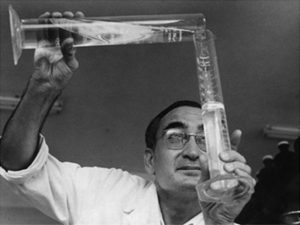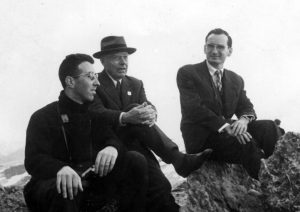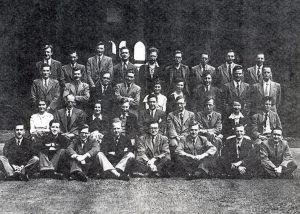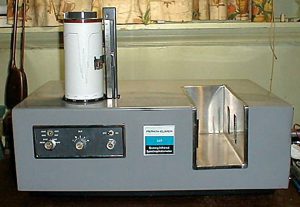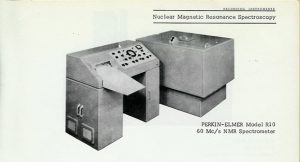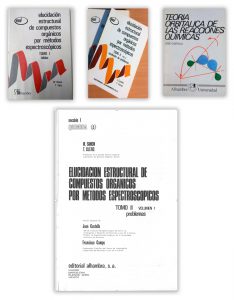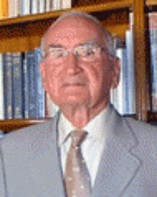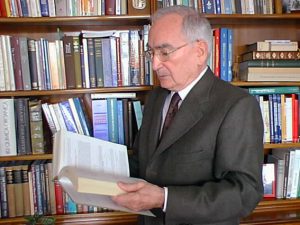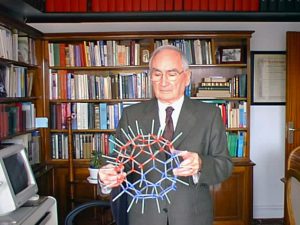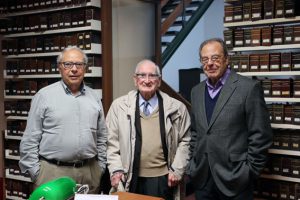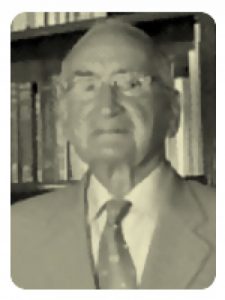
Dr. Josep Castells Guardiola was born in Barcelona on May 27, 1925, the son of the doctor Feliu Castells Farrarons and Josefina Guardiola Rosa. His father, apart from being a good doctor, was appointed doctor of the Barça first team during the term of President Rafael Llopart (1915-16). Josep Castells attended high school at the Balmes Institute during the turbulent years of the “uncivil” war (1935-1942) and obtained a degree in Sciences, Chemistry Section, from the University of Barcelona (UB) in 1947 (with Extraordinary Prize, 1948).
He immediately began the work of his doctoral thesis, directed by Professor Josep Pascual Vila, a thesis he defended in Madrid in 1951; It must be remembered that then only doctoral theses were defended at the Central University of Madrid. The work consisted of the isolation, in crystalline form, and chemical characterization of the cis and trans stereoisomers of 2-hydroxycyclopentanecarboxylic acid, which was published in Anales (1950) and in the Journal of the American Chemical Society (1952). Spectroscopic procedures did not yet exist to carry out faster characterization. During this period Castells was a fellow of the “Juan de la Cierva” Board of Trustees (CSIC). Upon completion of the thesis he obtained a post-doctoral aid to travel to the laboratories of Prof. Sir Ewart R.H. Jones of the University of Manchester where under the direct direction of Dr. G.D. Meakins worked on steroid chemistry, earning in 1955 a PhD degree from this university.
Back in Barcelona, around 1956, he joined the Alonso Barba Chemistry Institute as a collaborating scientist attached to “Juan de la Cierva” Board of Trustees, with a position at the UB Chair of Organic Chemistry (Prof. Josep Pascual). In this position, and taking advantage of the research and teaching environment of this chair, Castells developed an important and passionate task to introduce the new experimental methodologies he had learned in England, column chromatography, spectroscopic techniques (IR, NMR …), and the new concepts on chemical bonding, especially covalent, and the mechanisms of organic reactions: nucleophile, electrophile, inductive and resonant effects, descriptors SN1, SN2, E1, E2, etc., described by Sir Christopher Ingold (1893- 1970). During that time at the UB three five-year periods of splendor followed in which Professor Dr. Pascual and Drs coexisted. Manuel Ballester Boix, Josep Castells Guardiola and Fèlix Serratosa Palet (three members of the CSIC and trained in foreign postdocs) together with a relatively well-endowed financing for the time (Fundación Juan March, CSIC, USA Departments…). The research carried out in Organic Chemistry was transmitted by osmosis not only to doctoral students but also to undergraduate students. And in this transmission Dr. Castells participated intensively.
The efforts of Dr. Castells to acquire as a priority for all of Spain the different affordable spectroscopes that appeared commercially are worthy of mention. Noteworthy is the first IR, a 1962 Perkin Elmer Infracord 137, an R-10 permanent magnet NMR spectroscope, 60 MHz, in 1965, a gas chromatograph, and a mass spectrometer from 1968, when the group of Dr. Pascual moved to the CSIC building in Pedralbes (Research and Development Center, CID). At the same time, Castells dictated spectroscopic seminars accompanied by very careful notes, which some ended up being books. Indeed, Drs. Josep Castells and Francisco Camps translated the book by W. Simon and T. Clerc into Spanish under the title “Elucidación estructural de compuestos orgánicos por métodos espectroscópicos. Tomo I, Tablas; Tomo II, Vol. I, problemas” (Ed. Alhambra, 1970); and in his own words “so that his experience would be more useful to a broader sector of organic chemicals, we resolved to publish the solutions to the problems indicated in the aforementioned book, exposing them analogously to how they were reasoned in the seminars: “ibid, Tomo II, Vol. II, Resolución de problemas” (Ed. Alhambra, 1970). These books became so popular that in 1977 a translation of the expanded second edition was made.
His spectroscopic teaching extended to Chile with a 4-month stay at the Universities of Valparaíso and Santiago thanks to the sponsorship of UNESCO (1962).
But we would fall short if we only mentioned as important milestones those related to spectroscopy. Dr. Castells was also an indefatigable researcher, with research aimed primarily at the synthesis of new organic compounds. From his stay in Manchester with Sir Ewart Jones in the 1950s he published seven more works (one in Chem. & Ind., 1956; another in Proc. Chem. Soc., 1958; five in J. Chem. Soc., 1959, 1960 [two] and 1962 [two]). As a member of the CSIC, first attached to the UB, and of the new building of the Research and Development Center (CID), he published twenty-eight articles until 1975 (some also signed from the UAB), many of them in the best magazines of the specialty.
Although being recognized nationally and internationally with outstanding prestige, Castells understood that his task should be done from the university, a place where he could develop the two facets of researcher and teacher that boiled within him in the image and likeness of the Anglo-Saxon countries. This dream was realized through a journey of competitions-opposition: a first failed attempt at the Chair of Organic Chemistry of the Faculty of Medicine of Cádiz (1957) and a second attempt, also unsuccessful, opposing the Chair of Organic Chemistry of the UB (1967); finally, later, he became a tenured associate professor of Organic Chemistry at the UAB -1972- (he has been a research professor at the CSIC and a tenured professor at the UAB since 1968) and a tenured professor of Organic Chemistry at the UAB in 1975, passing the same year to Professor of Organic Chemistry at the Faculty of Chemistry of his alma mater, the UB, filling the gap that Prof. Ricardo Granados left when he moved to the Faculty of Pharmacy.
At the UAB, starting from total zero, he created and organized an Organic Chemistry Department dedicated body and soul to research and teaching: he provided the empty spaces of the laboratories with all the modern and appropriate material to do good research, He acquired all the modern spectroscopic techniques (IR, H and C-13 NMR, GC coupled to MS, etc.), organized a good library and, above all, designed a teaching plan for the degree in Chemistry that was copied by all the Faculties. of Chemistry of the Spanish state. He surrounded himself with a good team: teachers, including the punctual incorporation of Dr. Fèlix Serratosa, and fellows. He started some summer seminars, lasting from 10 to 15 days, with professors from all over (J. Elguero, M.J. Makosza, F. Montanari, R. Huisgen, E.L. Eliel, H. Rapoport…); seminars that continued later at UB (R. Hoffmann, J. M. Lehn, R.B. Merrifield, E.J. Corey, B. Trost, D.A. Evans, S. Masamune…).
When Castells entered the position of Professor of Organic Chemistry at the University of Barcelona, he achieved what was probably his greatest illusion sighted for many years. His arrival at the Department of Organic Chemistry coincided with the already established presence of what has been the brightest promotion of young organic chemists at the UB, as the future has shown.
He implemented, with all its consequences, the 1974 study plan, which he was already a father at the UAB, and encouraged and helped to initiate lines of research, in which he did not participate, but which over time were fundamental in our science, demonstrating its strategic vision and generosity in a period when these virtues were scarce in the closed Spanish scientific circle. He managed to get his good friend Serratosa to join the department on a service commission, leading an excellent research group in Organic Synthesis and teaching the subject of Synthesis Design, a pioneer in Spain and in line with the most advanced in the world. Simultaneously, the Faculty allowed its own organization of the fifth year of the Bachelor’s degree in its specialty in Organic Chemistry so that students could do very high-level internships for two months full-time.
He continued his work of publishing books for teaching, especially Basic or General Chemistry: “Química General” (Editorial Alhambra, 1981), intended for first-year students of the Bachelor of Chemistry and “Química General y Bioorgánica” (Editorial Alhambra, 1985), configured to simplify the above and add Biochemistry and Biology materials, as explained in the prologue, aimed at students of Biology and Medicine. The fundamental characteristic of both books was the extraordinary rigor with which the different subjects were developed, with special emphasis on Thermodynamics and Kinetics, arid aspects and difficult for non-specialists in the field to understand. Precisely because of this rigor, these two books were perhaps not the best for the study of an average student, but they were invaluable for the teachers who had to teach the corresponding subjects.
When the development of the University Reform Law began in 1984, the so-called “Non-Numerary Teachers” (NNTs) were regularized through so-called Suitability Tests. To qualify these tests, national commissions were established by areas of knowledge that the PNNS should promote numerary adjunct professors who accredited sufficient merits. The National Commission for Organic Chemistry was chaired by Dr. Castells in recognition of his intellectual status and, what was probably more important, his undeniable honesty.
At UB, Dr. Castells continued, with the invaluable help of Dr. Francisco López Calahorra, a pioneering line of research in Chemistry on functionalized polymeric supports. He had started it a few years earlier at the CID with two seminal publications, he continued it at the UAB and culminated it at the UB, in a series of works that combined solid phase chemistry and the study of processes catalyzed by thiazole salts in a biomimetic synthesis of monosaccharides from formaldehyde, as well as an in-depth study of the reaction mechanism of these processes. In this context, Prof. Castells organized in June 1988 in Barcelona the 4th International Conference on Polymer Supported Reactions in Organic Chemistry attended by the first figures of a field then leader in Organic Chemistry and that over time has given place, among others, in the so-called Combinatorial Chemistry. Castells remained in the Faculty of Chemistry of the UB until 1990, by forced retirement (Law 30/1984) with 65 years, remaining as professor emeritus for a few more years.
However, Castells was always open to issues related to the chemical community. He actively participated between 1955 and 1965 with the National Association of Chemists and Chemical Engineers of Spain (ANQUE), of which he was secretary of the Barcelona delegation, and in the creation of the College of Chemists; He was also one of the main organizers of the biennial meetings of the Organic Chemistry Group of the Royal Spanish Chemistry Society (the first took place in Santa María de Huerta in 1966, where he was appointed vice president of the group and later became president in 1981- 85); He also held the position of Secretary General of the UAB (1973-76).
Attentive to all the innovations in science, his informative mastery, at the end of his life trajectory, was exceptional, especially as a full member of the Science and Technology Section of the Institute of Catalan Studies (IEC), where he entered in 1978, and in the Royal Academy of Sciences and Arts of Barcelona (RACAB), where he entered in November 1984. I highlight some topics that the Royal Academy dealt with: use of hydrogen as an energy vector (with the organization of a week specifically dedicated to this topic); new organic materials such as fullerene and graphene; thermodynamic concepts made available to first-year students and chemistry teachers; stellar nucleosynthesis; evolutionary cosmogony especially of carbon chemistry as a central and singular element of the periodic table that bottom-up necessarily connects with molecular biology and therefore with life.
And wherever he went he always took care of the libraries and their modernization. At the UB he laid the foundations for a new “seminar” turning it into what is now the most efficient and modern chemistry library in Catalonia. And in the RACAB the computerization process of the catalog began, making possible the incorporation of its bibliographic collection in the Collective Catalog of Catalan Universities (CCUC) with external financing and consolidating the library staff with the graduates in Documentation and Librarianship who collaborated (Mrs. Josefina Fortuny and Mr. Ivan Rodas).
In fact, he was active and passionate in everything he did: tennis, bridge, surf… he didn’t really stop, and he was, in his own words, recalling Marañón, “a rag-picker of time”.
For all his work, Prof. Josep Castells was awarded the Narcís Monturiol Medal (1989) by the Government of Catalonia, the Gold Medal for Scientific Merit (1996) by the Barcelona City Council and the Solvay Prize (1996) awarded by the Spanish Confederation of Business Organizations (CEOE). He was a Corresponding Academician of the Royal Academy of Exact, Physical and Natural Sciences (1984 to 2018).
Dr. Josep Castells Guardiola married Mrs. María Dolores Portabella on March 31, 1989 in the Basilica of Santa María del Mar.
Professor Castells published about 100 scientific works, in peer-reviewed journals and a series in academic institutions (RACAB, IEC) that were compiled in a work published at the University of Barcelona. This work, under the care of Prof. Francisco López Calahorra and which can be accessed by contacting this Professor, was delivered to Prof. Castells at the lunch-tribute held when he turned 90 years old.
Acknowledgments
This biographical note has been made by Josep Font Cierco, Professor of Organic Chemistry at the Autonomous University of Barcelona (UAB). The author wants to thank Dr. Francisco López Calahorra for his invaluable help on writing the UB period.

